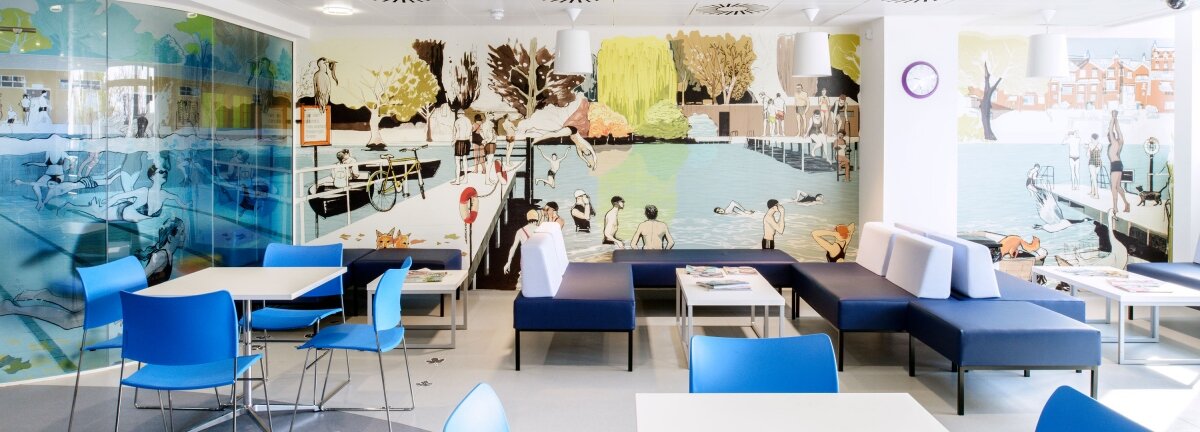Innovative codesign project reinvents the hospital waiting room

On 4 December, Whittington Health’s new Ambulatory Care Centre opened. This innovative new space has been built within the walls of the Victorian hospital, and allows more patients to receive seamless, same-day acute treatment. After working with the Design Council to improve the outpatients’ pharmacy department, the hospital recommissioned Studio TILT to adopt the same codesign approach for its Ambulatory Care Centre.
The success of the pharmacy project had shown staff at the Whittington that the design process could help improve the experience and efficiency of hospital services for both patients and staff. The new centre had to be a dynamic space, allowing for a range of different departments with a wide spectrum of treatments for both children and adults. Fundamental to the design was the idea that this should be an entirely new kind of space – a chance to create a world-class unit that didn’t feel like a hospital.
In order to fully understand how the centre needed to operate, Studio TILT ran workshops with more than 70 people across the Trust including managers, clinicians, administrators, infection prevention and control staff and patients. This gave everyone using the space a voice in the design process.
After exhaustive prototyping using full-scale mock ups of the new space, architecture practice Levitt Bernstein then helped realise the innovative designs and ensure technical standards were met.
Clarissa Murdoch, Lead Consultant Ambulatory Care, explained: “This was a very ambitious project and we wanted the needs of the patients to come first. We wanted to get away from a traditional model with long waiting times and create a less complex communal space to ensure a coordinated patient journey where their medical needs were met in a friendly environment.”
The centrally located phlebotomy booth combines so much of what is successful about the new centre. While private when necessary, it is positioned directly in the communal space demonstrating the centre’s challenge to clinical traditions of keeping treatments, waiting and administration separate. The space quite literally demonstrates the integrated care model.
Levitt Bernstein commissioned illustrator Alex Green to produce a series of murals that transformed and enhanced clinical areas, creating a more social, relaxing environment and incorporating clear, colour-coded way-finding systems. Green’s illustrations represent a radical departure from conventional hospital waiting and treatment areas. As Alex put it: “The aim of the murals was to soften the clinical, often stressful hospital space, putting patients at ease in a more informal environment.”
The flow of the centre is shaped as a ‘figure eight’, which passes all cubicles and treatment rooms allowing infection control and easy mobility for staff and patients. Many areas have been created as multifunctional, including the children’s play area, which doubles as a designated observation area. Children can be treated with ease without even being aware.
I confirm I have seen the future of Healthcare in the UK. This new centre is a fantastic experience for the patients by fusing together the skills in the community with this exceptional centre of excellence.
Norman Lamb, Minister of State for Care and Support
On opening the new ACU, Minister of State for Care and Support Norman Lamb commented on the design approach to the new centre: “I confirm I have seen the future of Healthcare in the UK. This new centre is a fantastic experience for the patients by fusing together the skills in the community with this exceptional centre of excellence. Patients here are very enthusiastic about their experience and appreciate how different it is to a busy A&E department."
Natalie Richard, Lead Consultant Ambulatory Care, explained the importance of the space: “It means that just because you are in the centre, you don’t have to be sitting in a bed space, and for children that is really important.”
Design Council Services Manager, Pauline Shakespeare, said: “We believe transforming public services has to begin with people. That’s why we're delighted that Whittington Health are building on the success of the outpatients’ pharmacy project and taking user-led design to other parts of the hospital."
Find out more
Find out more about our previous work redefining the user experience of Whittington Hospital Pharmacy.
Subscribe to our newsletter
Want to keep up with the latest from the Design Council?
